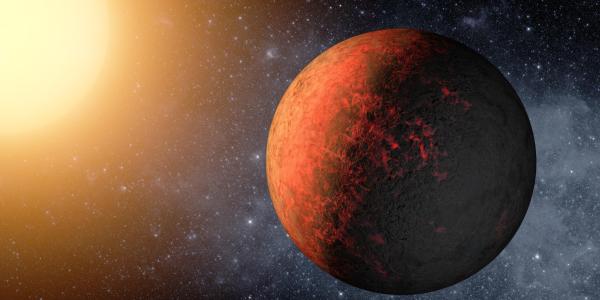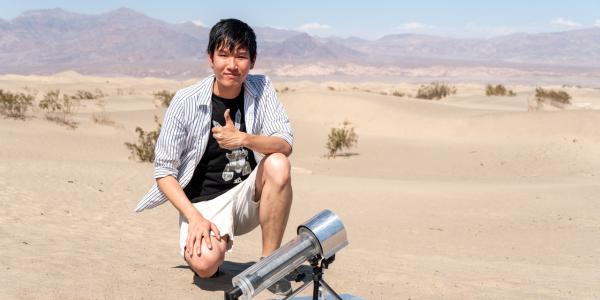Paul Byrne explains what Earth, Venus, and Mars reveal about the search for life beyond our solar system.

How unusual is Earth, and are we alone in the universe? Those fundamental questions have inspired philosophers and scientists for centuries. Thanks to technological advances, today’s astronomers can do more than merely speculate about other worlds. As of late 2025, astronomers have confirmed more than 6,000 exoplanets, bodies that orbit stars other than our own. “These are real worlds, and some might even have life,” said Paul Byrne, an associate professor of Earth, environmental, and planetary sciences. “Maybe they have scientists who are asking the same questions about their place in the universe.”
In a recent issue of JGR Planets, Byrne and co-author Bruce Jakosky of the University of Colorado Boulder explored what we can and can’t know about exoplanets. The distance to these other worlds poses challenges, but Byrne and Jakosky say we can learn some important lessons by considering planets closer to home, including the one beneath our feet.
Byrne, who is also a fellow of the McDonnell Center for the Space Sciences, spoke with the Ampersand about the knowns and unknowns of distant worlds.
How do astronomers find exoplanets?
Finding a planet beyond our solar system isn’t as easy as simply looking through a telescope. For the most part, astronomers can only infer the existence of planets by studying the light from stars. If starlight dims or warps at predictable intervals, they can deduce that an orbiting planet periodically blocks part of our view. Remarkably, we can learn a lot about a planet’s size, composition, and distance from its home star through such observations.
What makes an exoplanet a good candidate for possibly supporting life?
When thinking about the possible conditions on an exoplanet, it’s important to consider the star it orbits. We can carefully measure a star’s size, temperature, and activity. These qualities can be crucial to the ultimate fate of a planet. A hot, highly active star with a lot of solar flares could easily strip away the atmosphere of an orbiting planet, making life on the planet impossible.
The size, location, and composition of the planet are also fundamentally important. Astronomers searching for potentially habitable worlds are most interested in rocky planets that are roughly the size of Earth or maybe 50% to 60% larger. Crucially, the planet has to be in a so-called habitable zone where liquid water can exist on the surface. If a planet is too close to its home star, any water would vaporize. Too far away, and any water would freeze solid, which is not helpful for life.
We’ve detected a lot of Earth-sized worlds, but we have yet to find an Earth-like world, which is to say a planet of the right size orbiting the right kind of star at the right distance to suggest it could harbor life.
What can Earth, Venus, and Mars tell us about the possibilities of life on other planets?
In our JGR Planets paper, we make the case that our solar system should be a cautionary tale for anyone who wants to speculate about the conditions of a particular exoplanet. Earth, Venus, and Mars would look very similar to alien astronomers peering at our solar system from light years away, but those three worlds obviously had very different fates.
Some distant astronomer might rightly assume that Mars is too small to hold onto a substantial atmosphere for a long period of time. But that same astronomer might also wrongly conclude that Venus was more likely than Earth to have life because it’s closer to the Sun, which should give it more warmth and energy to support life. They wouldn’t know that Venus’s surface temperature is over 800°F because of its runaway greenhouse effect.
We wrote our paper to remind astronomers and exobiologists that simply knowing the approximate size and position of an exoplanet isn’t enough to make confident predictions about its habitability. As Earth, Mars, and Venus show us, we would also need to know about each planet’s unique geologic features to really have a good sense of its habitability.
What can we tell about a planet’s geology and atmosphere from light-years away?
It would be a lot easier if we could just visit these planets in a spaceship. Still, we’re getting to a point where we can study planets despite the great distances. When a large planet passes in front of a star, we can see the starlight coming through the atmosphere, which makes it possible to measure the atmospheric elements. In some cases, we know enough about a distant planet to make weather forecasts. That blows my mind.
Some observations just raise more questions. For example, we can tell whether or not a planet has a magnetic field. In theory, planets with fields might be better able to hold on to an atmosphere for a long period of time. But we know that Venus doesn’t have a magnetic field, and it certainly has an atmosphere. Once again, our close neighbors are a reminder that we need to be careful making assumptions about distant worlds.
Are you frustrated by all the uncertainty surrounding exoplanets, or is it exciting?
It’s definitely exciting, and it’s only getting better. As technology improves, we’re bound to find more and more exoplanets. I’m confident that we’ll identify an Earth-like planet — again, that’s a rocky planet of Earth-like size orbiting at the right distance from the right type of star — within my lifetime. We might even be able to tell if that planet has an atmosphere like ours or more like Venus. We still won’t know if that planet — or any planet — actually has life, but it’s fun to imagine the possibilities.
Header illustration credit: NASA/Ames/JPL-Caltech





